Study of the Gas Distribution in a Multiphase Rotodynamic Pump Based on Interphase Force Analysis
Abstract
:1. Introduction
2. Test System
3. Numerical Methodology
3.1. Governing Equations
3.2. Interphase Forces
3.3. Structured Mesh Information
3.4. Boundary Conditions and Numerical Solution Settings
4. Results and Discussions
4.1. Model Validation
4.2. Phase Interaction Characteristics in Impeller and Guide Vane
4.3. Gas Distribution in the Impeller Passage
4.4. Gas Distribution in the Guide Vane Passage
5. Conclusions
- (1)
- For the interphase forces in impeller and guide vane passages at IGVF = 21%, the magnitude ratio of non-drag forces to drag was generally less than 1, while the magnitude ratio of turbulent dispersion force to drag was always less than 0.2, which indicates that the drag was dominant and the turbulent dispersion force was very small relative to the drag in the multiphase rotodynamic pump.
- (2)
- Due to the rotation of the impeller and the rotor-stator interaction, the interphase forces of drag, added mass, and lift near the inlet and outlet of the impeller increased significantly. Meanwhile, with the increased IGVF, the variation range of interphase forces in the impeller was greater than that in the guide vane.
- (3)
- Due to the rotation effect of the impeller and the adverse pressure gradient in the flow passages, the gas in the impeller mainly accumulated near the hub of the impeller outlet. The higher the IGVF, the higher the aggregation degree and gas inhomogeneity therein, thus resulting in the increased interphase forces in the impeller passage.
- (4)
- The regularities of gas distribution in the guide vane were similar at different IGVFs, mainly accumulating near the guide vane hub, and gradually spreading to the mainstream region along the streamwise direction. Additionally, due to the divergent structure of the guide vane, obvious vortexes emerged at the hub. With increased IGVF, the degree of aggregation of gas and the range of gas vortexes—which are both located near the guide vane hub—became larger.
Author Contributions
Acknowledgments
Conflicts of Interest
Nomenclature
| Ak | Additional mass force of phase k, N/m3 |
| Model constant, dimensionless | |
| CA | Coefficient of additional mass force, dimensionless |
| CD | Drag coefficient, dimensionless |
| CL | Lift coefficient, dimensionless |
| cm2 | Meridional velocity at impeller outlet, m/s |
| CT | Coefficient of turbulent dispersion force, dimensionless |
| Db | Bubble diameter, mm |
| Dh1 | Hub diameter of impeller inlet, mm |
| Dh2 | Hub diameter of impeller outlet, mm |
| Dh3 | Hub diameter of guide vane inlet, mm |
| Dh4 | Hub diameter of guide vane outlet, mm |
| Dk | Drag force of phase k, N/m3 |
| Ds1 | Impeller shroud diameter, mm |
| Ds2 | Guide vane shroud diameter, mm |
| F2 | Blending function in SST-k-ω model |
| f | Mass force relevant to the rotation of the impeller, m/s2 |
| H | Pump head, m |
| Hd | Pump design head, m |
| Hl | Impeller axial length, mm |
| H2 | Guide vane axial length, mm |
| IGVF | Inlet gas void fraction, dimensionless |
| k | Turbulent kinetic energy, m2/s2 |
| Lk | Lift force of phase k, N/m3 |
| Mk | Total interphase force per unit volume, N/m3 |
| n | Rotational speed, r/min |
| ns | Specific speed, m3/4·s−3/2 |
| p | Static pressure, kPa |
| Q | Q-criterion |
| qv | Discharge, m3/s |
| Re | Reynolds number, dimensionless |
| SkΦ | Source item |
| S | Invariant measure of the strain rate |
| Tk | Turbulent dispersion force of phase k, N/m3 |
| Ug | Gas velocity, m/s |
| Ul | Liquid velocity, m/s |
| u2 | Velocity of the impeller outlet, m/s |
| w | Relative velocity, m/s |
| Z1 | Impeller blade numbers, mm |
| Z2 | Guide vane blade numbers, mm |
| Greek symbols | |
| αk | Volume fraction of phase, % |
| β′ | Model constant, dimensionless |
| ΓkΦ | Diffusion coefficient, dimensionless |
| σ | Surface tension coefficient, N/m |
| μk,t | Turbulent viscosity, Pa·s |
| μ | Molecular viscosity, Pa·s |
| μkeff | Effective viscosity, Pa·s |
| Density of phase k, kg/m3 | |
| Mixture density of phases, kg/m3 | |
| Φk | Universal variable |
| φ | Discharge coefficient, dimensionless |
| ψ | Head coefficient, dimensionless |
| ω | Rotational frequency of the impeller, 1/s |
| Subscripts | |
| k | Phase |
| g | Gas phase |
| l | Liquid phase |
References
- Omrani, A.E.; Franchek, M.A.; Ebrahimi, B.; Mutlu, M.; Grigoriadis, K. Low-dimensional modeling of a pumping unit to cope with multiphase. J. Dyn. Syst. Meas. Control 2017, 139, 041010. [Google Scholar] [CrossRef]
- Pirouzpanah, S.; Gudigopuram, S.R.; Morrison, G.L. Two-phase flow characterization in a split vane impeller Electrical Submersible Pump. J. Pet. Sci. Eng. 2016, 148, 82–93. [Google Scholar] [CrossRef]
- Suh, J.W.; Kim, J.W.; Choi, Y.S.; Kim, J.H.; Joo, W.G.; Lee, K.Y. Multi-objective optimization of the hydrodynamic performance of the second stage of a multi-phase pump. Energies 2017, 10, 1334. [Google Scholar] [CrossRef]
- Sun, J.W.; Kim, J.H.; Choi, Y.S.; Joo, W.G.; Lee, K.Y. A study on numerical optimization and performance verification of multi-phase pump for offshore plant. Proc. Inst. Mech. Eng. Part A J. Power 2017, 231, 095765091770226. [Google Scholar]
- Cao, S.L.; Peng, G.Y.; Yu, Z.Y. Hydrodynamic design of rotodynamic pump impeller for multiphase pumping by combined approach of inverse design and CFD analysis. J. Fluids Eng. 2005, 127, 330. [Google Scholar] [CrossRef]
- Zhang, W.W.; Yu, Z.Y.; Zhu, B.S. Numerical study of pressure fluctuation in a gas- liquid two-phase mixed-flow pump. Energies 2017, 10, 634. [Google Scholar] [CrossRef]
- Minemura, K.; Murakami, M. A theoretical study on air bubble motion in a centrifugal pump impeller. J. Fluids Eng. 1980, 102, 446–453. [Google Scholar] [CrossRef]
- Minemura, K.; Murakami, M. Three-dimensional calculation of air-water twophase flow in centrifugal pump impeller based on a bubbly flow model. J. Fluid. Eng. Trans. ASME 1993, 115, 766–771. [Google Scholar] [CrossRef]
- Verde, W.M.; Biazussi, J.L.; Sassim, N.A.; Bannwart, A.C. Experimental study of gas-liquid two-phase flow patterns within centrifugal pumps impellers. Exp. Therm. Fluid Sci. 2017, 85, 37–51. [Google Scholar] [CrossRef]
- Zhang, J.Y.; Cai, S.J.; Li, Y.J.; Zhu, H.W.; Zhang, Y.X. Visualization study of gas-liquid two-phase flow patterns inside a three-stage rotodynamic multiphase pump. Exp. Therm. Fluid. Sci. 2016, 70, 125–138. [Google Scholar] [CrossRef]
- Zhang, J.Y.; Cai, S.J.; Zhu, H.W.; Zhang, Y.X. Experimental investigation of the flow at the entrance of a rotodynamic multiphase pump by visualization. J. Pet. Sci. Eng. 2015, 126, 254–261. [Google Scholar] [CrossRef]
- Sato, S.; Furukawa, A.; Takamatsu, Y.; Sato, S.; Furukawa, A.; Takamatsu, Y. Air-water two-phase flow performance of centrifugal pump impellers with various blade angles. Bull. JSME 2008, 39, 223–229. [Google Scholar] [CrossRef]
- Poullikkas, A. Effects of two-phase liquid-gas flow on the performance of nuclear reactor cooling pumps. Prog. Nucl. Energy 2003, 42, 3–10. [Google Scholar] [CrossRef]
- Schäfer, T.; Bieberle, A.; Neumann, M.; Hampel, U. Application of gamma-ray computed tomography for the analysis of gas holdup distributions in centrifugal pumps. Flow Meas. Instrum. 2015, 46, 262–267. [Google Scholar] [CrossRef]
- Yan, D.; Kovacevic, A.; Tang, Q.; Rane, S.; Zhang, W.H. Numerical modelling of twin-screw pumps based on computational fluid dynamics. Proc. Inst. Mech. Eng. Part C 2016, 231, 4617–4634. [Google Scholar] [CrossRef]
- Zhu, J.J.; Zhang, H.Q. Mechanistic modeling and numerical simulation of in-situ gas void fraction inside ESP impeller. J. Nat. Gas Sci. Eng. 2016, 36, 144–154. [Google Scholar] [CrossRef]
- Tremante, A.; Moreno, N.; Rey, R. Numerical turbulent simulation of the two–phase flow (1iquid/gas) through a cascade of an axial pump. ASME J. Fluids Eng. 2002, 124, 371–376. [Google Scholar] [CrossRef]
- Benhmidene, A.; Chaouachi, B.; Bourouis, M.; Gansi, S. Numerical prediction of flow patterns in bubble pumps. J. Fluid Eng. 2011, 133, 031302. [Google Scholar] [CrossRef]
- Situ, R.; Hibiki, T.; Brown, R.J. Flow regime transition criteria for two-phase flow at reduced gravity conditions. Int. J. Multiph. Flow 2011, 37, 1165–1177. [Google Scholar] [CrossRef] [Green Version]
- Yu, Z.Y.; Zhu, B.S.; Cao, S.L.; Liu, Y. Effect of virtual mass force on the mixed transport process in a multiphase rotodynamic pump. Adv. Mech. Eng. 2015, 6. [Google Scholar] [CrossRef]
- Yu, Z.Y.; Zhu, B.S.; Cao, S.L. Interphase force analysis for air-water bubbly flow in a multiphase rotodynamic pump. Eng. Comput. 2015, 32, 2166–2180. [Google Scholar] [CrossRef]
- Tabib, M.V.; Schwarz, P. Quantifying sub-grid scale (SGS) turbulent dispersion force and its effect using one-equation SGS large eddy simulation (LES) model in a gas-liquid and a liquid-liquid system. Chem. Eng. Sci. 2011, 66, 3071–3086. [Google Scholar] [CrossRef]
- Lane, G.L.; Schwarz, M.P.; Evans, G.M. Numerical modelling of gas-liquid flow in stirred tanks. Chem. Eng. Sci. 2005, 60, 2203–2214. [Google Scholar] [CrossRef]
- Tan, L.; Zhu, B.S.; Wang, Y.C.; Cao, S.L.; Gui, S.B. Numerical study on characteristics of unsteady flow in a centrifugal pump volute at partial load condition. Eng. Comput. 2015, 32, 1549–1566. [Google Scholar] [CrossRef]
- Zhang, W.W.; Yu, Z.Y.; Zhu, B.S. Influence of tip clearance on pressure fluctuation in low specific speed mixed-flow pump passage. Energies 2017, 10, 148. [Google Scholar] [CrossRef]
- Hao, Y.; Tan, L.; Liu, Y.b.; Xu, Y.; Zhang, J.S.; Zhu, B.S. Energy performance and radial force of a mixed-flow pump with symmetrical and unsymmetrical tip clearances. Energies 2017, 10, 57. [Google Scholar] [CrossRef]
- Liu, D.Y. Fluid Dynamics of Two-Phase Systems; Higher Education Press: Beijing, China, 1993; pp. 26–31. [Google Scholar]
- Johnson, R.W. The Handbook of Fluid Dynamics; CRC Press: Boca Raton, FL, USA, 1998; pp. 21–22. [Google Scholar]
- Pourtousi, M.; Sahu, J.N.; Ganesan, P. Effect of interfacial forces and turbulence models on predicting flow pattern inside the bubble column. Chem. Eng. Process. 2014, 75, 38–47. [Google Scholar] [CrossRef]
- Mohajerani, M.; Mehrvar, M.; Eincmozaffari, F. CFD analysis of two-phase turbulent flow in internal airlift reactors. Can. J. Chem. Eng. 2012, 60, 1611–1630. [Google Scholar] [CrossRef]
- Fu, W.S.; Lai, Y.C.; Li, C.G. Estimation of turbulent natural convection in horizontal parallel plates by the Q criterion. Int. Commun. Heat Mass 2013, 45, 41–46. [Google Scholar] [CrossRef]
- Hunt, J.C.R.; Wray, A.A.; Moin, P. Eddies, Streams, and Convergence Zones in Turbulent Flows; Center for Tubulence Research: Moffett Field, CA, USA, 1988. [Google Scholar]
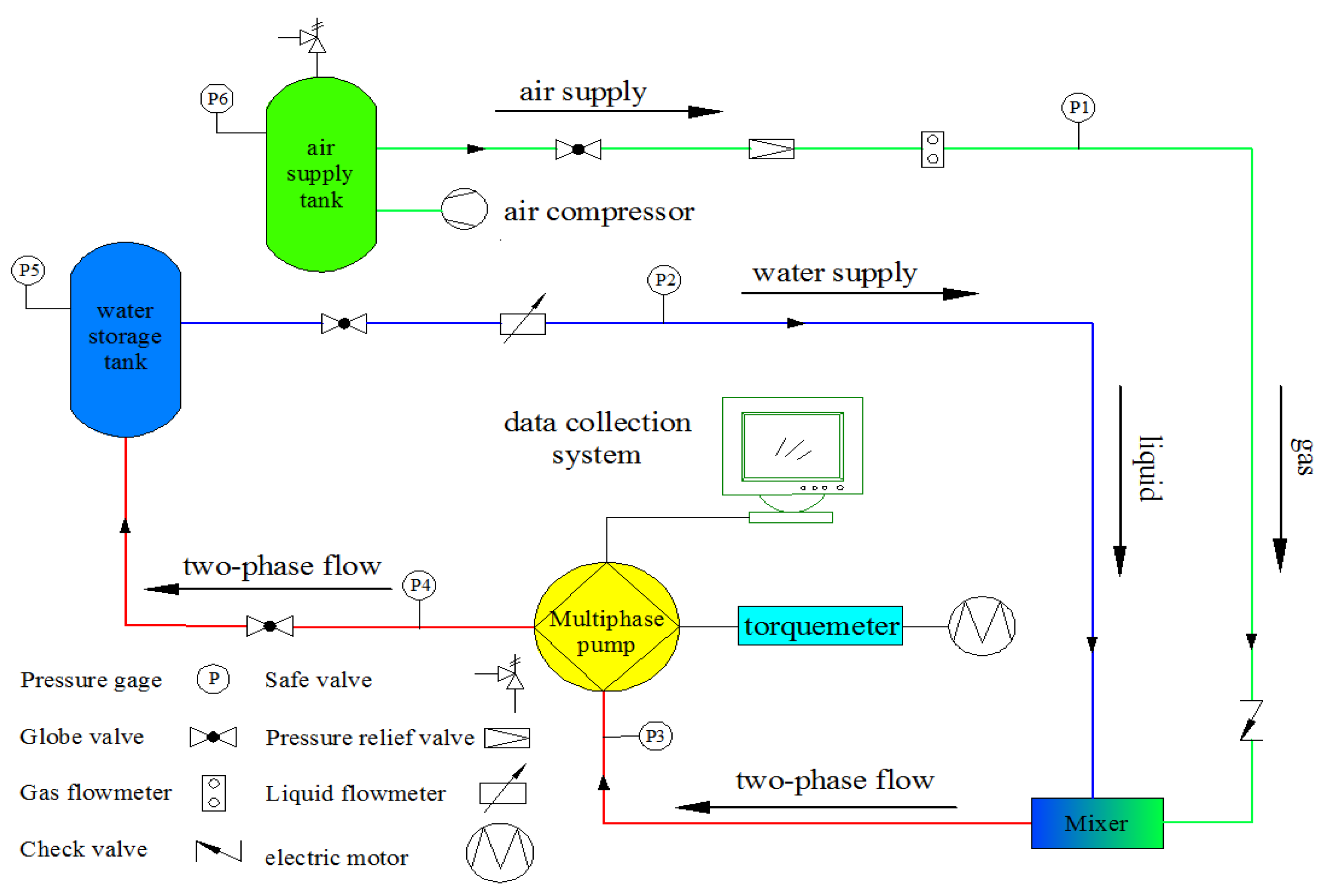
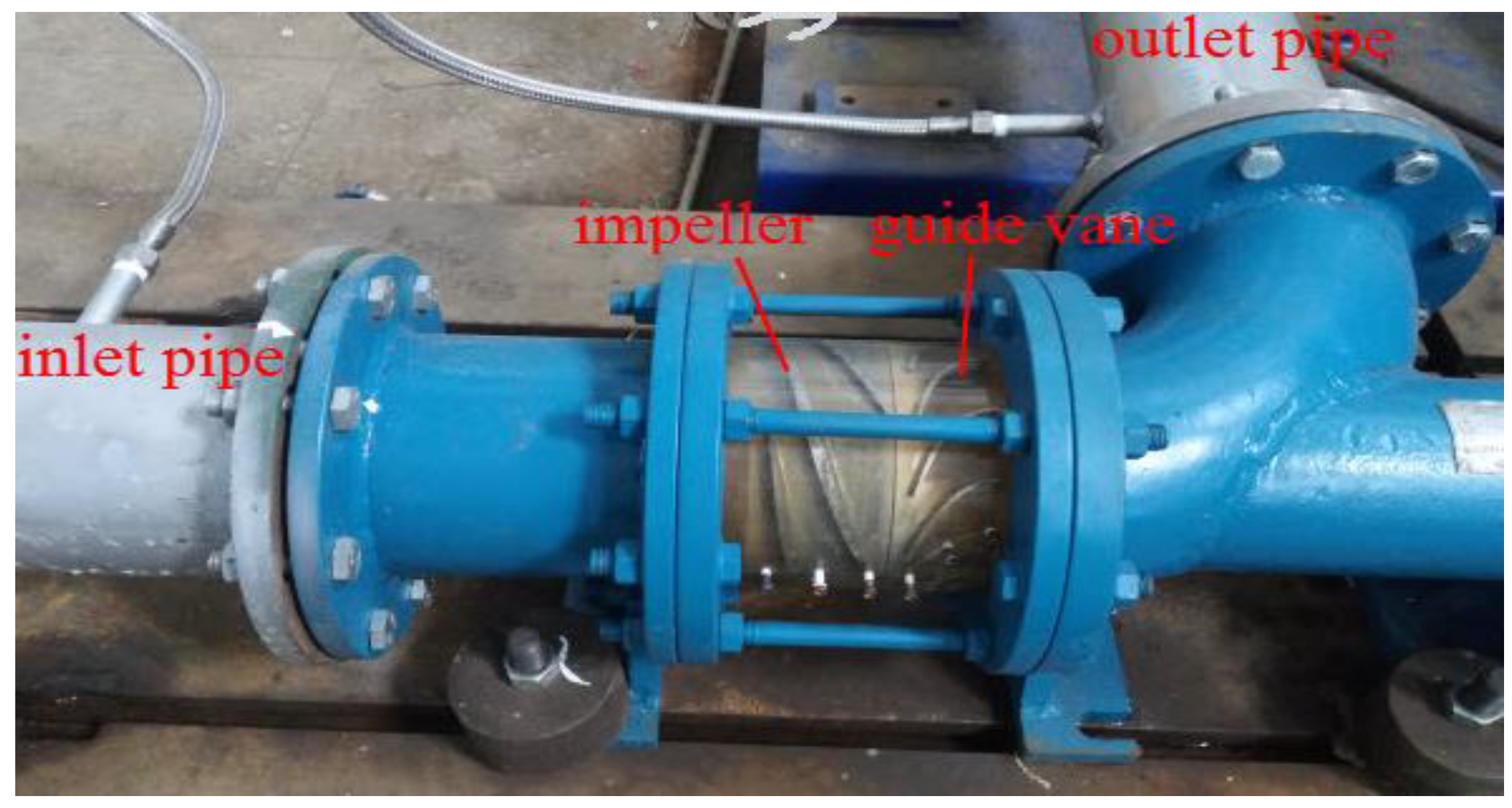
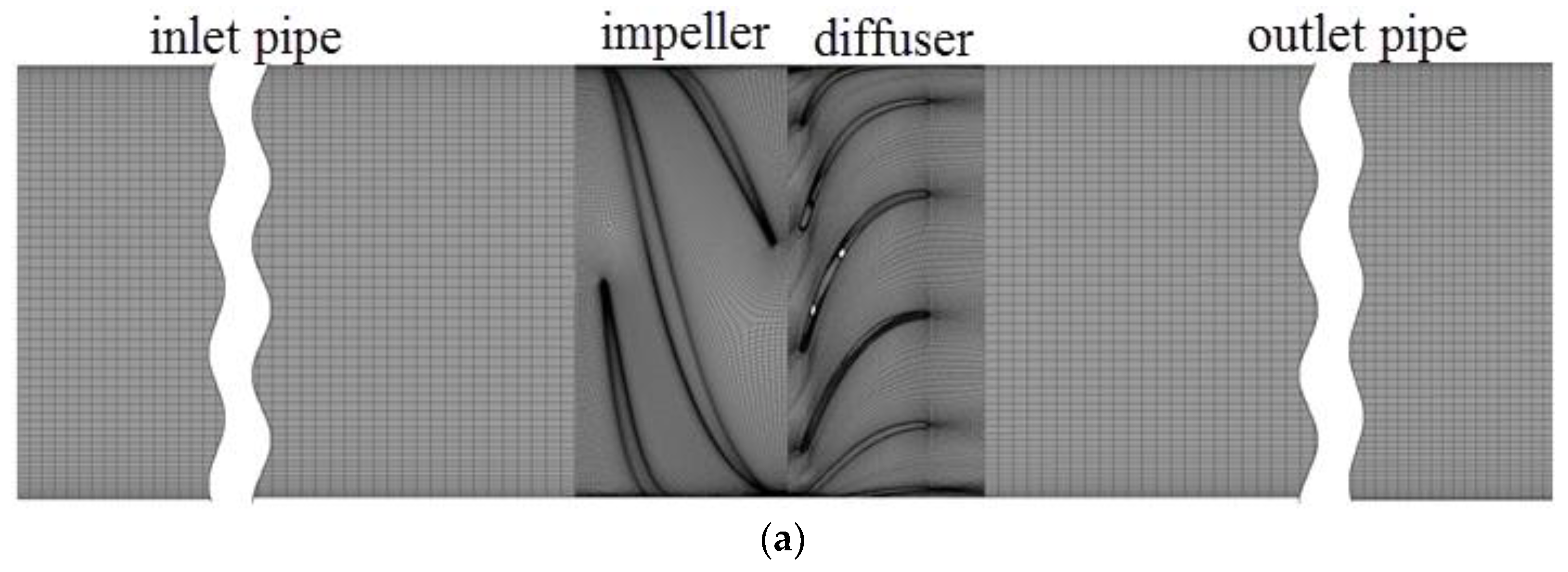



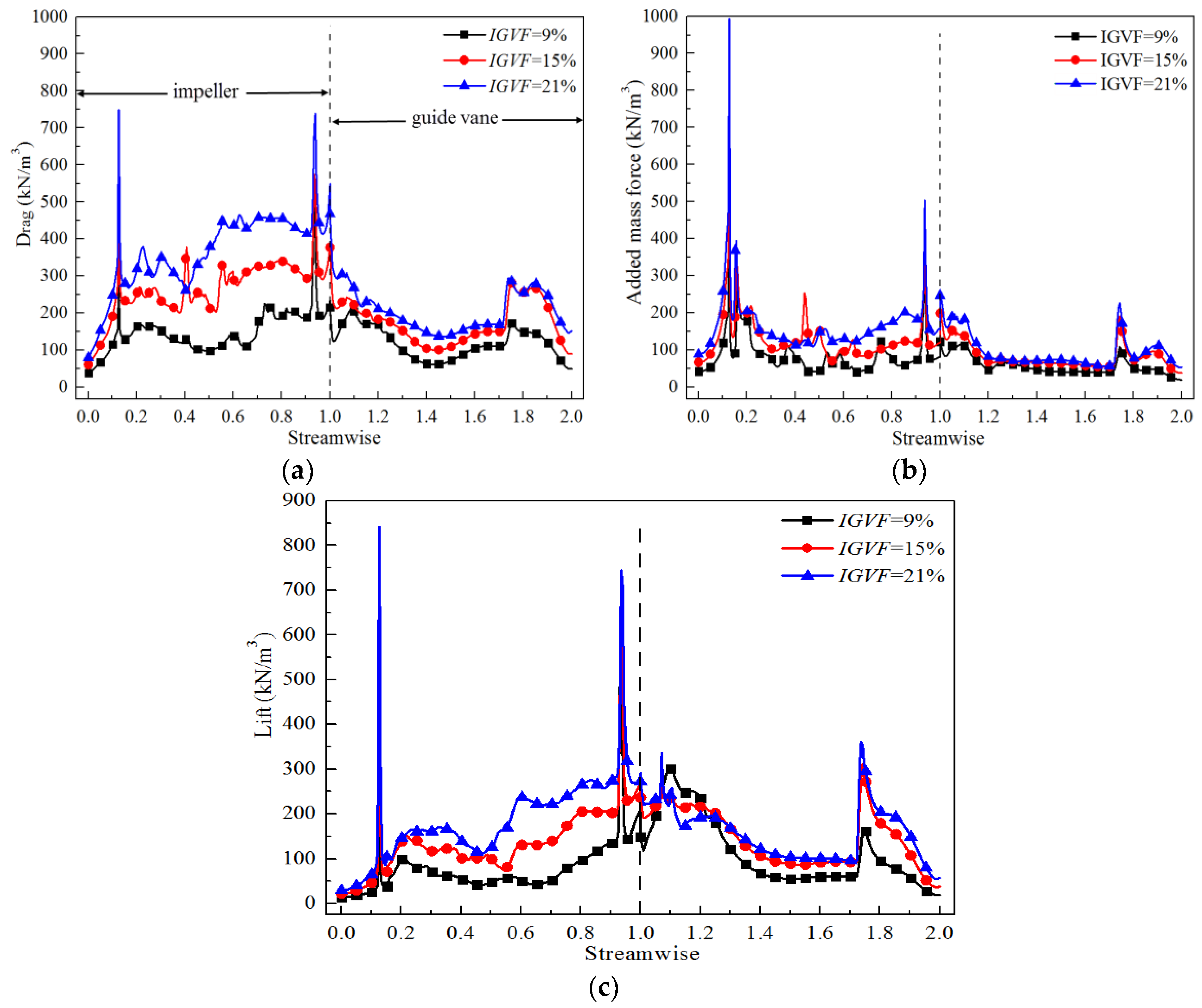


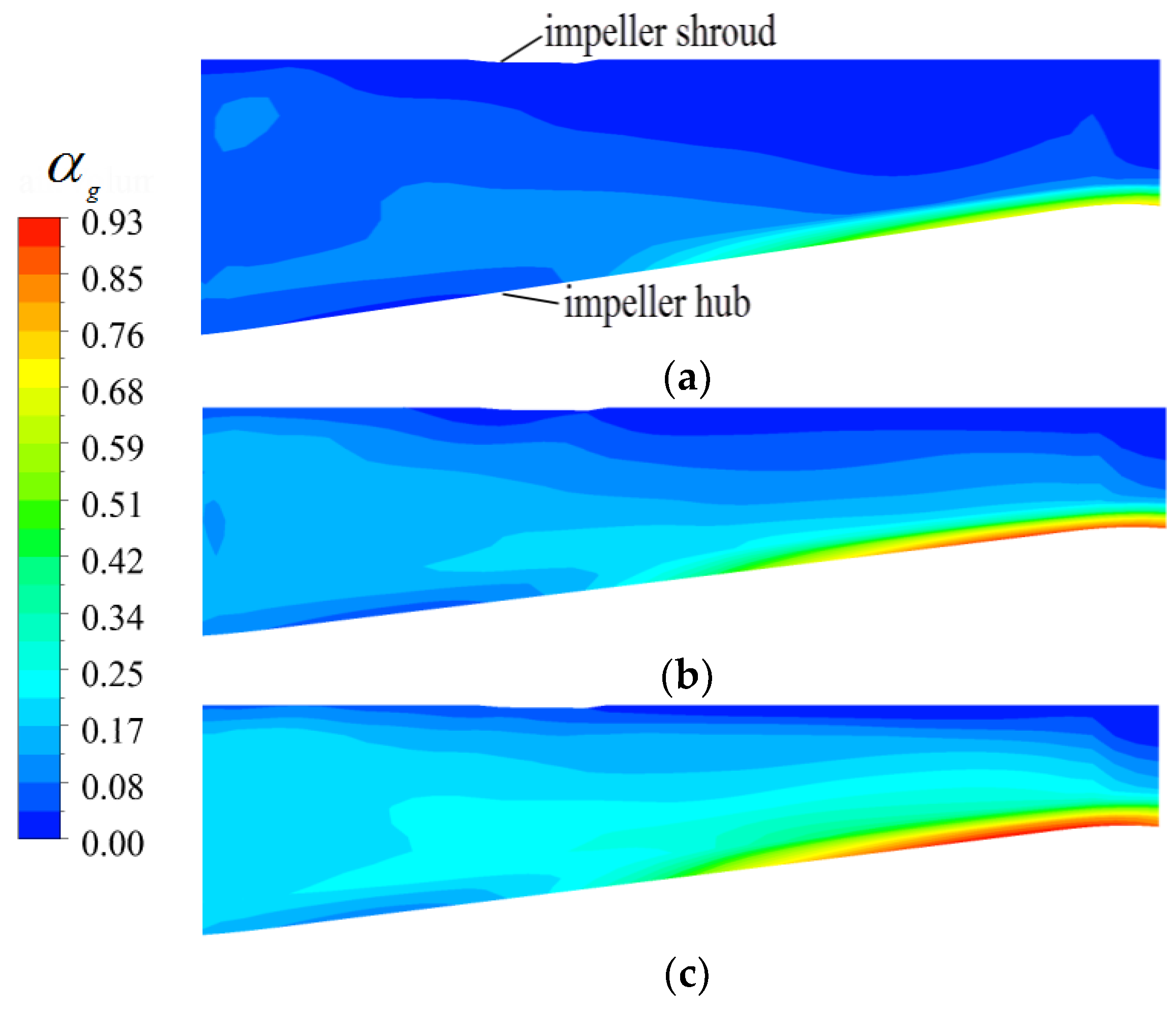


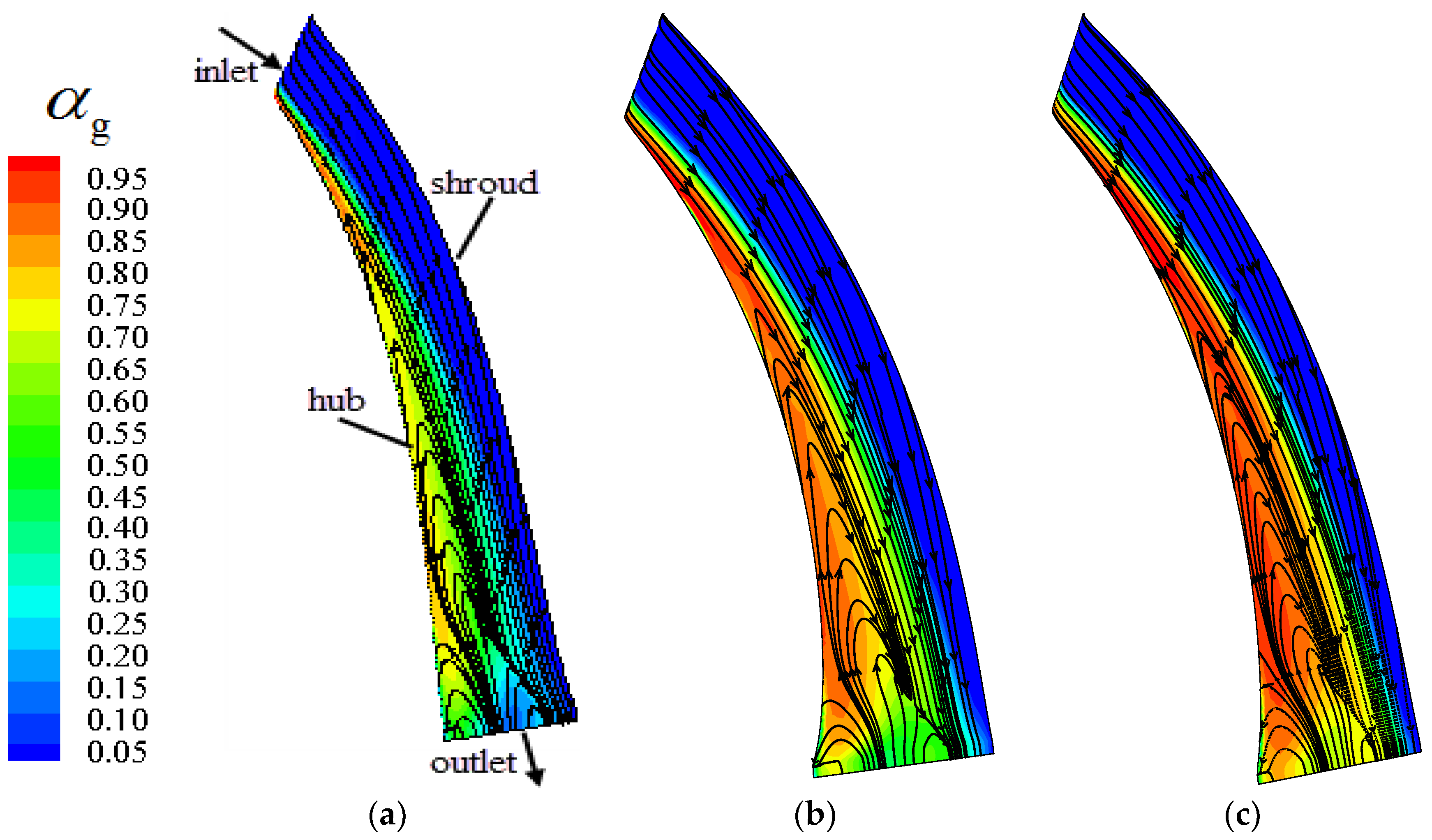

| Multiphase Pump | Items | Values | Units |
|---|---|---|---|
| Impeller | Shroud diameter Ds1 | 150 | mm |
| Hub diameter of inlet Dh1 | 120 | ||
| Hub diameter of outlet Dh2 | 134 | ||
| Axial length Hl | 60 | ||
| Blade numbers Z1 | 4 | dimensionless | |
| Guide vane | Shroud diameter Ds2 | 150 | mm |
| Hub diameter of inlet Dh3 | 134 | ||
| Hub diameter of outlet Dh4 | 120 | ||
| Axial length H2 | 40 | ||
| Blade numbers Z2 | 11 | dimensionless | |
| Design condition | Rotational speed n | 2950 | r/min |
| Discharge coefficient φ | 0.168 | dimensionless | |
| Head coefficient ψ | 0.274 | ||
| Specific speed ns | 166 | m3/4·s−3/2 |
| Forces | Expressions | Coefficients |
|---|---|---|
| Dk | [21,22] | |
| Ak | CA = 0.5 [29] | |
| Lk | CL = 0.5 [30] | |
| Tk | CT = 0.1 [21] |
| Items | Mesh I | Mesh II | Mesh III | Mesh IV |
|---|---|---|---|---|
| Inlet pipe | 54,516 | 54,516 | 54,516 | 54,516 |
| Impeller | 165,096 × 4 | 306,660 × 4 | 590,416 × 4 | 809,361 × 4 |
| Guide vane | 35,168 × 11 | 56,280 × 11 | 105,840 × 11 | 129,472 × 11 |
| Outlet pipe | 99,540 | 99,540 | 99,540 | 99,540 |
| Total (million) | 1.20 | 2.00 | 3.68 | 4.82 |
| Head coefficient | 0.261 | 0.259 | 0.256 | 0.256 |
| Efficiency/% | 58.23 | 57.73 | 57.14 | 57.13 |
| Items | Inlet Pipe | Impeller | Guide Vane | Outlet Pipe |
|---|---|---|---|---|
| Mesh type | hexahedral mesh | |||
| Orthogonality angle (0°–90°) | 88.7 | 82.2 | 73.6 | 85.9 |
| Mesh expansion factor (0–20) | 1.0 | 1.2 | 4.9 | 1.0 |
| Aspect ratio (0–100) | 2.4 | 13.9 | 18.2 | 2.8 |
| y+ | 233 | 66 | 10 | 331 |
| Items | Settings |
|---|---|
| Analysis type | Steady state |
| Advection scheme | Second order |
| Turbulence numerics | Second order |
| Residual RMS | <1 × 10−4 |
| Discharge coefficient φ | 0.168 |
| Inlet gas void fraction IGVF | 9%, 15%, 21% |
| Results | ψ_CFD (m) | ψ_EXP (m) | Error (%) | |
|---|---|---|---|---|
| Conditions | ||||
| IGVF = 0% | 0.312 | 0.303 | 2.97 | |
| IGVF = 9% | 0.296 | 0.290 | 2.07 | |
| IGVF = 15% | 0.282 | 0.273 | 3.30 | |
| IGVF = 21% | 0.269 | 0.265 | 1.51 | |
© 2018 by the authors. Licensee MDPI, Basel, Switzerland. This article is an open access article distributed under the terms and conditions of the Creative Commons Attribution (CC BY) license (http://creativecommons.org/licenses/by/4.0/).
Share and Cite
Zhang, W.; Yu, Z.; Zahid, M.N.; Li, Y. Study of the Gas Distribution in a Multiphase Rotodynamic Pump Based on Interphase Force Analysis. Energies 2018, 11, 1069. https://doi.org/10.3390/en11051069
Zhang W, Yu Z, Zahid MN, Li Y. Study of the Gas Distribution in a Multiphase Rotodynamic Pump Based on Interphase Force Analysis. Energies. 2018; 11(5):1069. https://doi.org/10.3390/en11051069
Chicago/Turabian StyleZhang, Wenwu, Zhiyi Yu, Muhammad Noaman Zahid, and Yongjiang Li. 2018. "Study of the Gas Distribution in a Multiphase Rotodynamic Pump Based on Interphase Force Analysis" Energies 11, no. 5: 1069. https://doi.org/10.3390/en11051069




